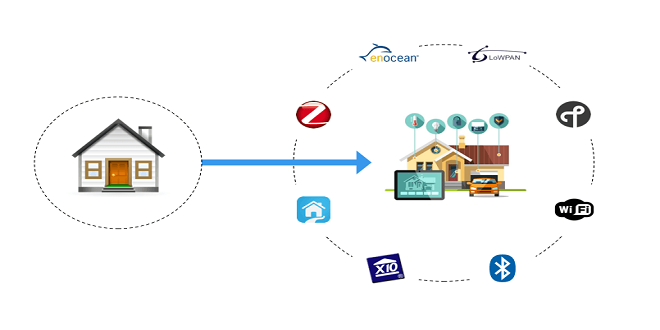Home Automation Network Protocols

While this discussion might be demanding for the reader, who has not yet dealt with communication protocols yet, its understanding is of utmost importance and the prerequisite for the ability to plan, design, and install a safe and performant smart home network. Trying to set up or change the configuration parameters of routers, smart hubs, and smart home devices without exactly knowing what you are doing is like playing the lottery: the chances to get it right are very small.
Network Address Translation (NAT)
The way a DSL router connects the devices in a private local area network (e.g. HAN) to the public Internet is through the process of Network Address Translation (NAT). For all communication with the public Internet, the DSL router is being assigned an external IP address, which has to be unique on the entire Internet. (This address by the way is rotated and changed by the Internet service provider every 24 hours or when the router restarts, unless you have a more expensive permanent IP address.) Towards the private local area network, the IP addresses do not need to be unique, but can randomly be selected from the below ranges: 10.0.0.0 – 10.255.255.255
UPnP
The UPnP protocol (Universal Plug and Play) together with the Internet Gateway Device Protocol (IGD) provides the functionality to automatically configure port forwarding on DSL routers. A typical use case in Hans is remote controllable webcams, refrigerators, baby phones, wall plugs or light switches, which use UPnP to connect to an external cloud service. Many routers have UPnP enabled per default so that a user with a UPnP-capable smart device can set up such devices without any changes to the router.
Dynamic DNS
Dynamic DNS resolves the problem, that the IP address of residential Internet/DSL routers is dynamically re-assigned by the Internet service providers (ISP), which causes it to change every 24 hours or every time the router reboots. This is why the router and with it any device inside the private network can only be reached from the outside if its current public IP address is known. Here the dynamic DNS services come into play. They work as follows: Routers, which need to be accessible from the Internet, periodically send their current IP address to a dynamic DNS server, where it is associated with a dedicated domain name. When this domain name is called, the dynamic DNS server responds with the current IP address of the router.
For more information please visit: isp reseller
Last word
Given the significant risk UPnP, dynamic DNS, and open router ports pose, the much safer approach of HTTP REST and HTTP Server Push has gained wide acceptance in the industry. Today the combined use of REST, OAuth 2.0, and HTTP-2 Server Push provides a secure framework for communicating from private networks to the public Internet and vice versa.





